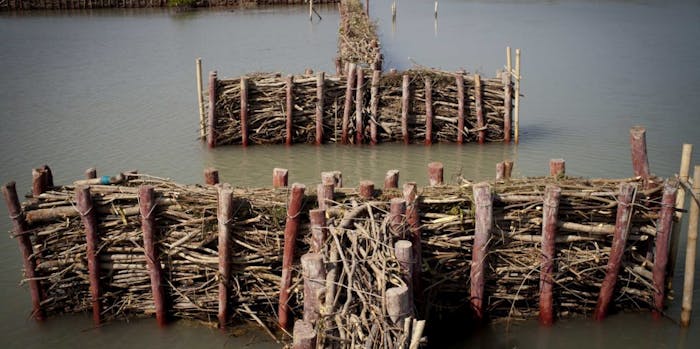Imagine Watching Powerlessly as Neighbourhoods Disappear Under Water
Kilometres of muddy coast in the province of Demark on the Indonesian island of Java have gradually been swallowed up by the sea over the past 35 years. For example, in the village of Bedono, two neighbourhoods - a total of 200 hectares - have disappeared. The cause: coastal erosion and rising sea levels.
Naturally occurring mangrove forests in the area have been increasingly chopped down to make way for fish and shrimp ponds as well as land clearance for urban development. Even though mangroves play an important role in coastal protection. Large quantities of groundwater are used for controlling the water quality of the ponds, causing sinking of the land. The increasing flooding of houses, agricultural land and roads means local fishermen and fish pond farmers have seen their incomes drop significantly, sometimes by as much as 80%.
There seemed to be no way to stop the erosion and floods. Major investments were made in sea walls and wave barriers, but all these efforts failed. In areas with soft muddy substrate like Demak hard structures only enhance erosion and often collapse. The floods kept creeping further into the villages and taking land by 100 meters every year. People became desperate and made plans to move away having witnessed neighbouring villages being swallowed up by the sea.
[Gentle music] Ingenious: Semipermeable dam Buidling with Nature solution boosts local economy [Gentle music] The Indonesians used to live [Gentle music] in harmony with nature [Gentle music] The strong population growth lead to increase need for food. [Gentle music] Mangroveforests were cut down in favour of fishponds. [Gentle music] Mangrove roots no longer contained the mud, nor protected the coast from wave impact. [Gentle music] The coast eroded. [Gentle music] At some locations the coastline moved inland by 1.5 kilometer. [Gentle music] Fishponds are a major source of income and… [Gentle music] ...now even the motorway is in danger. [Gentle music] ...now even the motorway is in danger. [Gentle music] The authorities built concrete sea walls to stop the erosion. [Gentle music] This failed. The mud is no firm basis for the wall. The turbulence caused by the waves… [Gentle music] …increased the erosion. [Gentle music] The EcoShape consortium came up with an innovative plan: [Gentle music] the semipermeable dam. [Gentle music] The bamboo piled dams with frush wood absorb the waves… [Gentle music] …but allow the sediment to pass. [Gentle music] In sections of 100 meters, calm circumstances are created for the sediment to settle. "[Gentle music] Mangrove trees will sprout, there is still enough seed around. When a section is overgrown enough…" [Gentle music] …new dams will be placed in front, until the original coastline is restored. [Gentle music] Building with Nature works. [Gentle music] The dams are built and maintained by the locals. [Gentle music] Nature does the rest. [Gentle music] The people are educated on how to make and… [Gentle music] …maintain the fioshponds and mangroves. [Gentle music] This is cost effective and… [Gentle music] …people regain their source of income.
- Mangrove coasts under threat
- Building with nature in Indonesia
- Permeable structure handover to local communities in Demak
- Struggle to protect the coasts in Demak
- Sustainable solution to massive erosion in Central Java
Created in partnership with:
![]() Deltares
Deltares

 13 Climate Action
13 Climate Action
 11 Sustainable Cities and Communities
11 Sustainable Cities and Communities